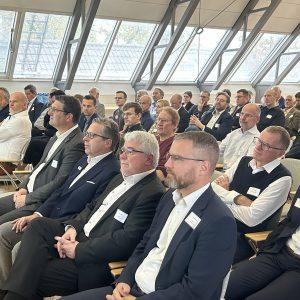ADVERTISING

Dr. Tim Flohrer from the ESA in Darmstadt about the growing threat from rubble in space and the urgent measures for a sustainable space travel
What actually happens with artificial air bodies in space when they no longer work? Since 1957, over 6,000 satellites have been brought to the earth's orbit, but only about 800 are functional. As a space junk, the rest circles around the earth, together with broken rocket parts and other debris from space travel. According to estimates by the European Space Organization (ESA), there are currently over 700,000 of those objects that are larger than one centimeter and move at the flag of earth at a rapid speed. Dr. Tim Flohrer heads the ESA Space Debris Office in Darmstadt and is a central figure in the area of space security. In his role, he monitored the development and spread of space junk, analyzed potential dangers and developed strategies to reduce the risk of collisions in space. An important part of his work is the coordination of international measures and cooperation with scientists and engineers to promote innovative technologies for waste disposal and prevention. Flohrer is committed to making the orbit more sustainable and ensuring security for future space missions. We spoke to him in the ESOC rooms in Darmstadt.
Mr. Flohrer, how serious is the problem of space scrap and how does it affect the future use of space?
In the late 1970s, NASA scientist Donald J. Kessler published a paper in which he showed that a chain reaction of collisions and fragmentation of space objects could occur. The topic initially only dealt with science. Later, players & operators of space travel increasingly deal with it. In February 2009, the first satellite collision occurred in the orbit. At the latest here, the topic moved into the broad public interest and for 2-3 years it has even been perceived as an environmental problem, especially the younger generation. In fact, “space scrap” influences space travel in many dimensions. Collisions could not only lead to functional failures, but also to significant cost increases for space companies and a substantial risk of manned space missions.
What specific measures does the ESA take to reduce or eliminate the increasing amount of space junk?
As, so to speak, we are strongly concerned with the development and modulation of the problem. We act as an exemplary, as a good model for other operators. Space is no longer a scientific space. More than 90% are commercial actors, only think of Elon Musk (SpaceX). Over 100 nations use satellites. This is because the costs for space programs have dropped significantly. As a “guideline”, we started the Zero Debris Charter in 2023, based on decades of work, to significantly limit the number of space residues in the earth and lunar ornate for all future missions, programs and activities of the agency. The ESA relies on technological innovations, clear guidelines and international cooperation to achieve this goal. Because one thing has to be clear to us: the space, however large it seems, is a limited resource, comparable to drinking water.
Are there specific examples of space missions or technologies in which the ESA successfully contributed to reducing space junk?
We have developed worldwide leading models of the "Space Safety" for the active removal of space waste in Darmstadt. For example, the planned Clearspace -1 mission, in which a defective satellite component is to be captured for the first time and brought to crash in a controlled manner. This mission serves as a prototype for future cleanup campaigns in space.
In addition, the ESA relies on preventive measures by developing new guidelines for the construction of satellites that ensure that after missionary there are no ruins in the orbit. This includes the obligation to build satellites in such a way that they move out of orbit independently after the end of their lifespan. With this combined strategy of surveillance, prevention and targeted disposal, the ESA actively focuses on sustainable use of space.
How does your office in Darmstadt work with international partners to develop a global strategy to combat space junk and are there legal or political challenges that the ESA is faced with in the fight against space, especially in an international context?
Our space law dates from the 1970s and 1980s and, in its current form, is not geared towards the problem of space scrap. The developed guidelines for minimizing space waste should urgently be transferred to international law. The importance of this implementation is particularly high for some countries, while others seem to be less affected. Nevertheless, the risk of space scrap remains the same for everyone - a global challenge that requires joint action by the nations.
All the more important is the development and importance of Zero Debris Charter, which was developed by the ESOC in cooperation with other players in the space industry. They defined both overarching leading principles and specific goals in order to significantly reduce the amount of space scrap by 2030. More than 100 signatories underline the will of states and operators, sustainability and a responsible handling of the resource of space as a serious issue.
What role does cooperation with private space companies play in the containment of space scrap, and how does the increasing space tourism affect this topic?
Coordination with commercial operators, such as Elon Musk, is of enormous importance, since the commercial share of services in space increases steadily. The amount and variety of satellite data grow rapidly, for example in areas such as telecommunications or services such as Google Maps. Even if space tourism is currently taking place on significantly deeper organs and residues are burning faster here, the growing use of space requires close cooperation to ensure the security for ESOC missions and projects of other actors.
What long -term strategies and innovations are the ESA plans to combat the problem of space scrap in the coming decades?
The further development to contain the space scrap is increasingly focusing on innovative technologies in the so -called "Orbit Services". Here, the focus is on the changeover from a linear to a circular economy to repair, convert or upgrade satellites in space, instead of leaving them down as an scrap after their lifespan. These approaches aim to use the limited resource "space" more efficiently, because the room is becoming increasingly narrower and the risk of collision is increasing. The repair and conversion of satellites should not only increase sustainability, but also extend the lifespan of the devices. At the same time, the challenge arises to develop sustainable and financed business models in order to cover the costs of such complex missions.












